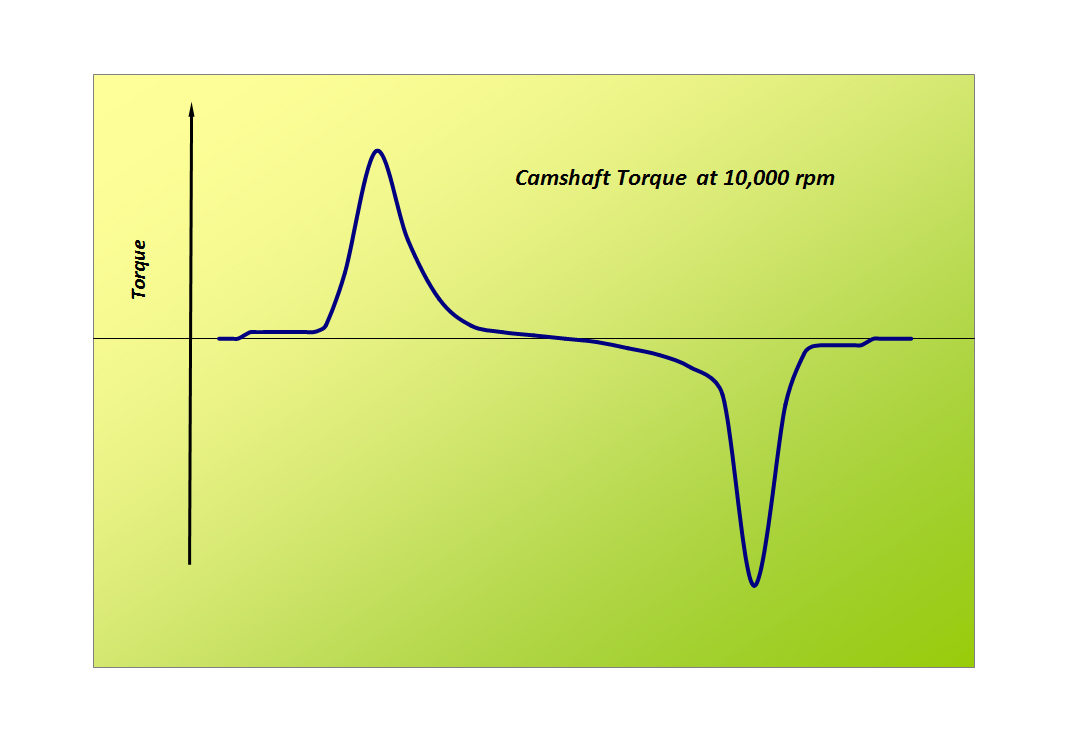Managing torsion vibration
While much has been written about the design of camshaft profiles and how to install and time them in an engine, comparatively few details are available about the actual dynamics in the valvetrain system due to the torsional vibrations induced.
Much like the engine crankshaft therefore, which can be excited by the forces of combustion and fail catastrophically when the frequency with which it is excited approaches the component’s natural frequency of vibration, the camshaft can also be subjected to such effects. Rarely does this lead to a torsional failure but, if unchecked, the vibration can have disastrous effects on components such as the valve timing or valve spring control.
If we take the case of an inlet camshaft opening and closing a single valve, the forces involved and hence the torques induced look similar to those outlined in Fig. 1. If you have ever tried to turn a camshaft over by hand you will realise that the forces required (and hence the instantaneous torques) can be surprisingly high, but once moving, the effort is considerably less, the force used to compress the valve spring being recovered when it expands a few degrees later. The total energy expended over a complete rotation may be minimal but the instantaneous forces at any one time to accelerate the valve opening can be amazingly high.
Now, if we consider that 140 cam degrees or so later, after the inlet cam closes, the exhaust cam will open, producing a similar set of forces but displaced by the 140º or so down the shaft. Again, the forces may be high but the overall energy input is low. If we then move along to the next cylinder in this engine (let us say it has four cylinders) we will realise that the inlet cam forces are similar to those of cylinder 1 but displaced by 90º (in the case of an engine firing at 1-3-4-2) and likewise the exhaust cam.
Repeating the exercise for cylinders 3 and 4, if we start to sum up all these instantaneous forces algebraically for the full four cylinders, the instantaneous torques produced at each angle around the camshaft could begin to cancel themselves out along the shaft. As a result, the peak torques will fall and the overall energy used to power the camshaft could be comparatively small. How small will depend on the precise timing of the inlet and exhaust cams to each other and the amount of friction in the system.
Clearly the greater the number of cam lobes along the shaft (say in an inline six – or even, god forbid, eight cylinder) the greater this smoothing effect.
In all cases, however, these instantaneous forces or torques will generate a level of vibration in the shaft which, when analysed or split up using a mathematical technique known as a Fourier analysis, will be represented as a large number of sine waves of different amplitude over a wide range of oscillating frequencies.
If the natural frequency of the shaft – or indeed any component in the system – is the same or close to any of these frequencies, and the forcing amplitude is sufficiently large, then unless it is damped in some way the shaft or component will resonate at that frequency, creating far higher loads than usual. This could be detrimental to either the performance of the unit or its durability. In the extreme case, with a hollow camshafts gun-drilled to remove much of the inner core, these forces could fatigue the component, or if the amplitude of vibration was such that it altered the valve events in relation to the piston position, then piston-to-valve contact could occur.
This issue is not normally a problem with small, low-speed or short engines, but arises in high-speed, multi-cylinder, multi-cam units where the need for weight reduction can be greatest or the search for outright performance paramount.
 Fig. 1 - Cam drive torque at 10,000 rpm engine speed
Fig. 1 - Cam drive torque at 10,000 rpm engine speed
Written by John Coxon